Sturgeon is the common name for the 28 species of fish belonging to the family Acipenseridae. The earliest sturgeon fossils date to the Late Cretaceous, and are descended from other, earlier acipenseriform fish, which date back to the Early Jurassic period, some 174 to 201 million years ago. They are one of two living families of the Acipenseriformes alongside paddlefish (Polyodontidae). The family is grouped into four genera: Acipenser, Huso, Scaphirhynchus, and Pseudoscaphirhynchus. Two species may be extinct in the wild, and one may be entirely extinct. Sturgeons are native to subtropical, temperate and sub-Arctic rivers, lakes and coastlines of Eurasia and North America. A Maastrichtian-age fossil found in Morocco shows that they also once lived in Africa.

Acipenseriformes is an order of basal ray-finned fishes that includes living and fossil sturgeons and paddlefishes (Acipenseroidei), as well as the extinct families Chondrosteidae and Peipiaosteidae. They are the second earliest diverging group of living ray-finned fish after the bichirs. Despite being early diverging, they are highly derived, having only weakly ossified skeletons that are mostly made of cartilage, and in modern representatives highly modified skulls.
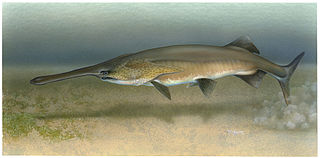
Paddlefish are a family of ray-finned fish belonging to order Acipenseriformes, and one of two living groups of the order alongside sturgeons (Acipenseridae). They are distinguished from other fish by their elongated rostra, which are thought to enhance electroreception to detect prey. Paddlefish have been referred to as "primitive fish" because the Acipenseriformes are among the earliest diverging lineages of ray-finned fish, having diverged from all other living groups over 300 million years ago. Both living and fossil paddlefish are found almost exclusively in North America and China.
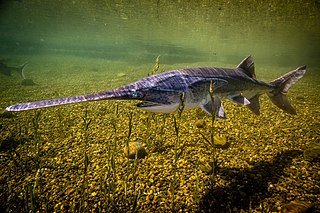
The American paddlefish, also known as a Mississippi paddlefish, spoon-billed cat, or spoonbill, is a species of ray-finned fish. It is the last living species of paddlefish (Polyodontidae). This family is most closely related to the sturgeons; together they make up the order Acipenseriformes, which are one of the most primitive living groups of ray-finned fish. Fossil records of other paddlefish species date back 125 million years to the Early Cretaceous, with records of Polyodon extending back 65 million years to the early Paleocene. The American paddlefish is a smooth-skinned freshwater fish with an almost entirely cartilaginous skeleton and a paddle-shaped rostrum (snout), which extends nearly one-third its body length. It has been referred to as a freshwater shark because of its heterocercal tail or caudal fin resembling that of sharks, though it is not closely related. The American paddlefish is a highly derived fish because it has evolved specialised adaptations such as filter feeding. Its rostrum and cranium are covered with tens of thousands of sensory receptors for locating swarms of zooplankton, its primary food source. The only other species of paddlefish that survived to modern times was the Chinese paddlefish, last sighted in 2003 in the Yangtze River in China and considered to have gone extinct no later than 2010.

The Chinese paddlefish, also known as the Chinese swordfish, is an extinct species of fish that was formerly native to the Yangtze and Yellow River basins in China. With records of specimens over three metres and possibly 7 m (23 ft) in length, it was one of the largest species of freshwater fish. It was the only species in the genus Psephurus and one of two recent species of paddlefish (Polyodontidae), the other being the American paddlefish. It was an anadromous species, meaning that it spent part of its adult life at sea, while migrating upriver to spawn.

Roe, or hard roe, is the fully ripe internal egg masses in the ovaries, or the released external egg masses, of fish and certain marine animals such as shrimp, scallop, sea urchins and squid. As a seafood, roe is used both as a cooked ingredient in many dishes, and as a raw ingredient for delicacies such as caviar.
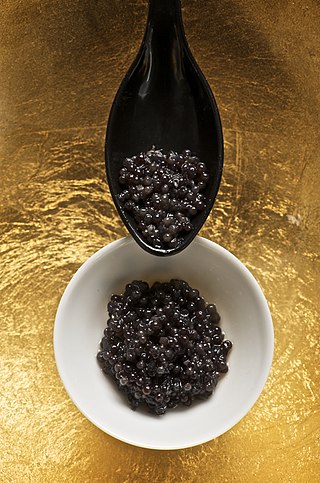
Beluga caviar is caviar consisting of the roe of the beluga sturgeon Huso huso. The fish is found primarily in the Caspian Sea, which is bordered by Iran, Azerbaijan, Kazakhstan, Russia, and Turkmenistan. It can also be found in the Black Sea basin and occasionally in the Adriatic Sea. Beluga caviar is the most expensive type of caviar, with market prices ranging from $7,000 to $22,000/kg.
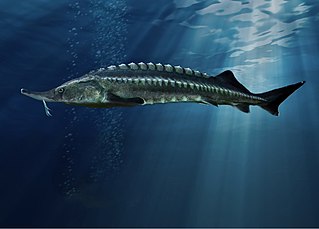
The beluga, also known as the beluga sturgeon or great sturgeon, is a species of anadromous fish in the sturgeon family (Acipenseridae) of the order Acipenseriformes. It is found primarily in the Caspian and Black Sea basins, and formerly in the Adriatic Sea. Based on maximum size, it is the third-most-massive living species of bony fish. Heavily fished for the female's valuable roe, known as beluga caviar, wild populations have been greatly reduced by overfishing and poaching, leading IUCN to classify the species as critically endangered.
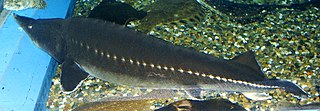
The kaluga, also known as the river beluga, is a large predatory sturgeon found in the Amur River basin from Russia to China and near Hokkaido in Japan. With a maximum size of at least 1,000 kg (2,205 lb) and 5.6 m (18 ft), the kaluga is one of the biggest of the sturgeon family. Like the slightly larger beluga, it spends part of its life in salt water. Unlike the beluga, this fish has five major rows of dermal scutes and feeds on salmon and other fish in the Amur with its nail-like teeth in its jaws. They have gray-green to black backs with a yellowish green-white underbelly.

Ossetra caviar is one of the most prized and expensive types of caviar. It is obtained from the Ossetra sturgeon, which weighs 50-400 pounds and can live up to 50 years.
Sevruga caviar is one of the highest priced varieties of caviar, eclipsed in cost only by the Beluga and Ossetra varieties. It is harvested from a variety of critically endangered sturgeon fish species, that are known for their small, grey colored eggs. In eastern Europe, it is harvested from the Sevruga sturgeon, the Sterlet sturgeon and the Siberian sturgeon, which are native to the Caspian Sea and the surrounding rivers.

Fauna of Azerbaijan or animal kingdom of Azerbaijan refers to the diversity of various types of animals, which inhabit and populate a defined ground or water area in Azerbaijan.

The starry sturgeon, also known as the stellate sturgeon or sevruga, is a species of sturgeon. It is native to the Black, Azov, Caspian and Aegean sea basins, but it has been extirpated from the last and it is predicted that the remaining natural population will follow soon due to overfishing.

The Persian sturgeon is a species of fish in the family Acipenseridae. It is found in the Caspian Sea and to a lesser extent the Black Sea and ascends certain rivers to spawn, mainly the Volga, Kura, Araks and Ural Rivers. It is heavily fished for its flesh and its roe and is limited in its up-river migrations by damming of the rivers. Young fish feed on small invertebrates, graduating to larger prey such as crabs and fish as they grow. The threats faced by this fish include excessive fishing with the removal of immature fish before they have bred, damming of the rivers, loss of spawning areas and water pollution. The International Union for Conservation of Nature has listed the fish as critically endangered and has suggested that the increased provision of hatcheries could be of benefit.

The Russian sturgeon, also known as the diamond sturgeon or Danube sturgeon, is a species of fish in the family Acipenseridae. It is found in Azerbaijan, Bulgaria, Georgia, Iran, Kazakhstan, Romania, Russia, Turkey, Turkmenistan, and Ukraine. It is also found in the Caspian Sea. This fish can grow up to about 235 cm (93 in) and weigh 115 kg (254 lb). Russian sturgeon mature and reproduce slowly, making them highly vulnerable to fishing. It is distinguished from other Acipenser species by its short snout with a rounded tip as well as its lower lip which is interrupted at its center.

Snail caviar, also known as escargot caviar or escargot pearls, is the fresh or processed eggs of land snails. It is a luxury gourmet speciality produced in Austria, Czechia, France and Poland. They were also a delicacy in the ancient world, also known as "pearls of Aphrodite" for their supposed aphrodisiac properties.
Kaluga Queen is a Chinese brand of caviar made by the caviar company Hangzhou Qiandaohu Xunlong Sci-Tech Co., Ltd. The company produces 60 tonnes of caviar annually, making it the largest producer of caviar in the world and responsible for 60% of world production. Kaluga Queen supplies caviar for 21 of the 26 3-starred Michelin restaurants in Paris.
Russian Caviar House is a Russian group of companies that grows sturgeon and sells black caviar. It is Russia's largest producer of black caviar.

The Caviar of Kladovo was a type of caviar produced in eastern Serbia. It was named after the town of Kladovo, in Central Serbia, part of the Danube's Iron Gates Gorge between Serbia and Romania. Made from various fishes' roe, the caviar was granted the protected geographic designation and was considered an expensive delicacy, which was even served on the RMS Titanic. With the construction of large dams in 1972 and 1984, jointly by the two states, the fish migrating from the Black Sea upstream the Danube were prevented from reaching their old spawning areas, and production of caviar was discontinued in the 21st century.

Exotic and Unusual Fishes of North America is a series of PBS documentary television specials about three species of American fish: The Alligator Gar: Predator or Prey?, The Paddlefish: An American Treasure, and Sturgeon: Ancient Survivors of the Deep. They were presented by KUHT Houston television station, and aired in the United States from 1992 to 1995.























